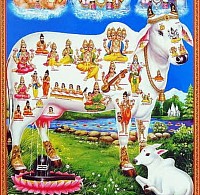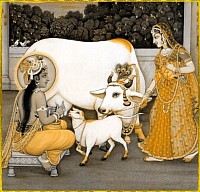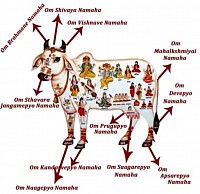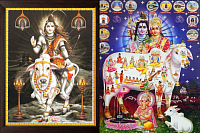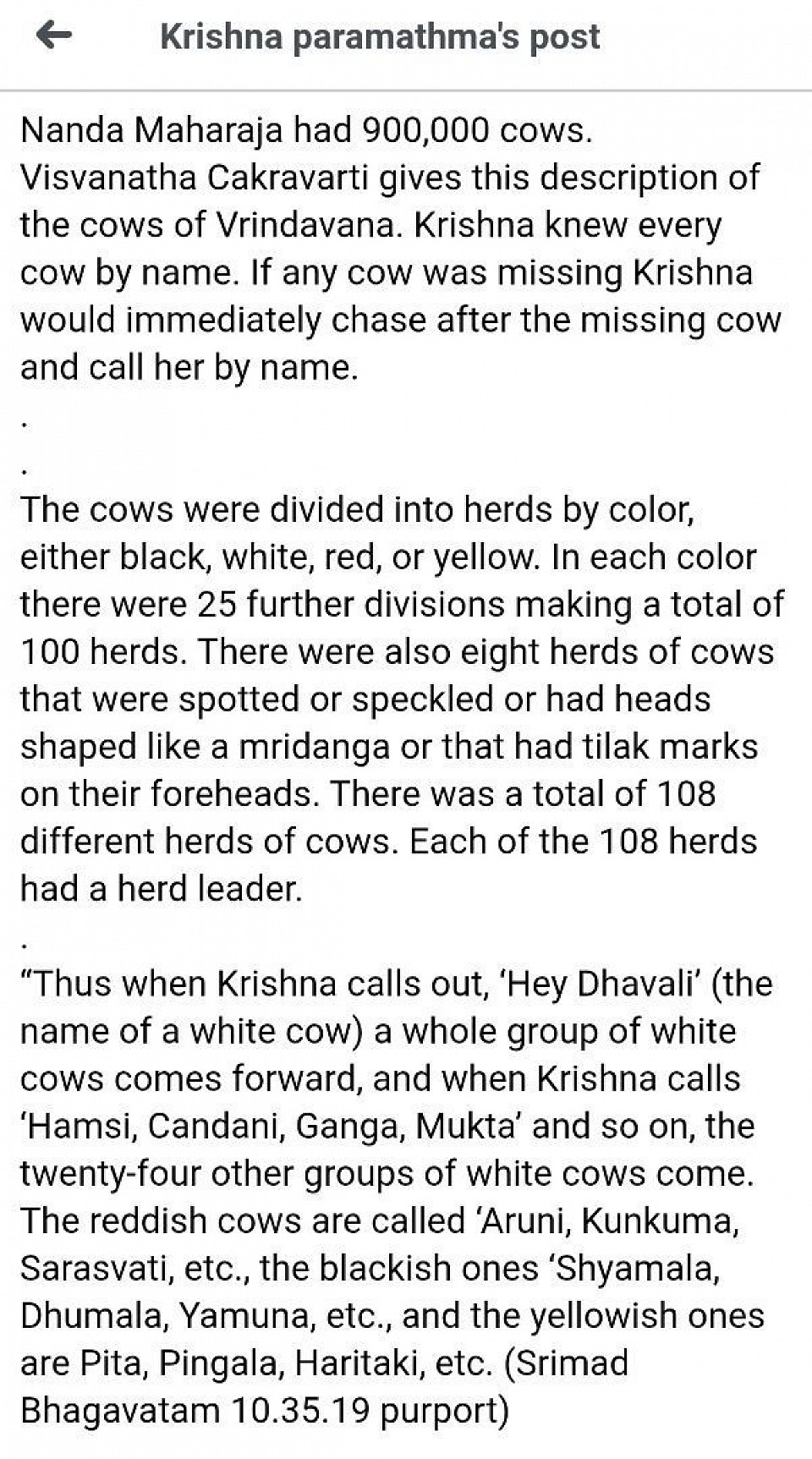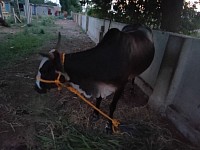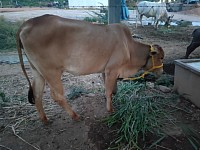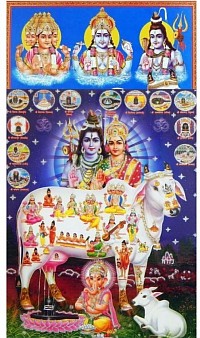KAMADHUNU
Kamdhenu is a mythical, wish-fulfilling divine cow in Hindu scripture, revered as the mother of all cows and a symbol of abundance, nourishment, and prosperity. Emerging from the cosmic ocean churning (Samudra Manthan), she embodies celestial blessings and is believed to reside with sages like Vashishta and Jamadagni, fulfilling their needs. Depicted variously as a divine cow with various gods within her or a unique form with human features and wings, she signifies the sanctity of cows, purity, and fertility.
Samudra Manthan: Kamdhenu was one of the precious treasures that emerged from the cosmic ocean during the Samudra Manthan, a major event in Hindu mythology.
Mother of All Cows: She is considered the progenitor of all cows, holding immense significance in the Hindu faith and culture.
Symbol of Abundance and Prosperity: Kamdhenu is known as the "Cow of Plenty" and a harbinger of wealth, happiness, and divine blessings.
Abode of Gods: Kamdhenu is often depicted as a divine cow with various gods and goddesses residing within her form.
Unique Celestial Being: She can also appear as a white cow with divine attributes like a crowned human head, peacock's tail, and wings, representing her unique celestial nature.
Sacredness of Cows: The reverence for Kamdhenu underscores the sacredness of cows in Hinduism, highlighting their role in providing essential resources like milk and ghee.
Companion of Sages: Kamdhenu resided in the hermitages (ashrams) of sages such as Vashishta and Jamadagni, fulfilling their spiritual and material needs.
Symbol of Protection: She also played a protective role, safeguarding the sages from harm and danger.
Uses Of Kamadhunu
Kamadhenu plays the important role of providing milk and milk products to be used in her sage-master's oblations; she is also capable of producing fierce warriors to protect him.
Cow called a Mother
Cows are called mothers, or "Gau Mata," in Indian culture and Hinduism primarily because they provide nourishing milk, similar to how a mother nurtures her child. They are also revered as a source of other essential products and services, such as cow dung and ox labor for farming, representing the divine bounty of the Earth and a fundamental part of the Sanatan Dharma way of life.
Here are the key reasons for the revered title:
Maternal Nourishment: A cow produces milk that nourishes humans from infancy to old age, much like a mother nourishes her child, making them a symbol of selfless giving and sustenance.
Gift of the Earth: The cow embodies the generous nature of Mother Earth, providing life-sustaining food and resources for human society.
Essential for Life: Besides milk, the cow provides other vital products like ghee and dung, used in traditional medicine (Ayurveda) and religious rituals. The ox, which comes from the cow, is crucial for plowing fields and producing grains, fruits, and vegetables.
Sacredness and Divinity: In Hinduism, cows are considered sacred and are believed to house 33 crore (330 million) gods and goddesses. They are seen as a fundamental foundation of ancient Indian culture and the Sanatan Dharma.
Symbol of Gratitude and Protection: This maternal status fosters a profound sense of gratitude and responsibility, leading to the practice of go-seva (serving the cow), go-puja (worshiping the cow), and go-rakshya (protecting the cow).
These interconnected aspects—nourishment, utility, and spiritual significance—lead to the cultural and religious reverence of the cow as "mother".
Benefits of owning a Kamdhenu
The Kamdhenu cow statue is a powerful symbol of wealth, health, peace, and spiritual upliftment. By placing a Kamdhenu statue in your home, you invite divine blessings that foster prosperity, good health, and harmonious relationships
Difference between Nandi and Kamdhenu
Kamadhenu, the "wish-fulfilling cow," symbolizes abundance, fertility, and prosperity, while Nandi, Lord Shiva's devoted bull, represents unwavering devotion and strength.
And also Nandi" and "Basava" both refer to the sacred bull of Lord Shiva, but "Basava" is a more common and accessible form of the name, often used interchangeably with Nandi, while "Nandi" emphasizes the deity's role as a bull and vehicle. The names are essentially the same concept, though "Basava" is particularly popular in Southern India and as a given name.
Worship of Black Cow in Vedic and Vastu
In Hindu tradition, a black cow holds significant spiritual meaning, symbolizing prosperity, purification, and spiritual growth, especially when donated. It represents qualities like fertility, stability, and endurance and is associated with mitigating negative energies and ensuring good health. In dream interpretations, a black cow can signify hidden fears or karmic burdens, often linked to the influence of Saturn, and may require patience or a spiritual transformation. HinduismSymbol of Purity and Piety: In Hinduism, the dark or black cow is seen as a symbol of purification, representing spiritual cleansing, particularly through acts of piety like charity during the Ekadashi festival. Prosperity and Blessing: Donating a black cow is believed to bestow powerful blessings, spiritual upliftment, and protection from negative energies, ensuring good health and prosperity for the donor and their family. Fertility and Stability: The black cow symbolizes fertility, abundance, grounding, stability, strength, endurance, and longevity. Spiritual Rituals: Black cows are central to various Hindu rituals and ceremonies, serving as important elements for spiritual purposes and well-being. Astrological Significance: In astrological contexts, a black cow may be donated during specific planetary periods, such as the Shani Dasha or Sadhesaati, to bring peace and balance. Dream InterpretationInner Fears and Burdens: When appearing in a dream, a black cow may symbolize hidden fears, unconscious anxieties, or karmic burdens that need to be addressed. Transformation and Patience: The presence of a black cow in a dream, particularly when linked to Saturn, can indicate a need for patience and a period of spiritual transformation or evolution. Personal Growth: Dreams are often a reflection of emotions and experiences, and a dream about a black cow can offer insights into your inner self and help you learn and grow.
Black cows have both meanings. Black cows represent hidden thoughts, financial luck, and are connected with unknown and transformations. But because black cows are associated with mystery, they can also represent betrayal or unforeseen events
In Buddhism, the Black bull symbolizes defeat and serves as the emblem of Assaka's tutelary deity, reflecting themes of struggle and spiritual challenges within the context of Buddhist teachings.
Black Kow provides moisture holding capacity to sandy soils and provides aeration and moisture holding capacity to hard, clay-type soils.
The black cow is a symbol of fertility, abundance, grounding, stability, strength, endurance, and longevity.
Worship of Red / Brown Cow in Vedic and Vastu
In Hindu belief, brown cows (like 'kapila-go') symbolize respect and prosperity, particularly in the context of feeding or gifting them, while red cows are sometimes linked to offerings or to symbolizing the Anubandhya sacrifice. The red heifer was a crucial animal for purification from ritual impurity, with its ashes mixed with water to create a cleansing solution.
Hinduism
Brown Cows: Generally, brown or brown-colored cows are associated with prosperity and respect, and they hold significance in offerings made during religious rituals.
Red Cows: Red cows can symbolize specific religious offerings and are linked to ancient sacrifices and spiritual benefits within Hindu practices.
In Vaishnavism, the term "brown cow" has two meanings.
In Hinduism, both brown and red cows carry spiritual significance, though their meanings differ: the brown cow, or Kapila, symbolizes a connection to Mother Earth, divine prosperity, and the sanctity of nature, while the red cow is specifically mentioned in religious texts as a sacrificial animal given to the deity Brihaspati. The reverence for cows stems from their association with nourishment, life, purity, and their role as a form of the divine Mother, Gau Mata.
Spiritual Meaning of the Brown Cow (Kapila)
Symbol of Nature and Mother Earth: The brown cow, often called "Kapila-go," is linked to Mother Earth and the natural world.
Divine Abundance: It represents the concept of abundance and prosperity within Hinduism, as embodied by the mythical cow Kamadhenu, the source of all prosperity.
Connection to Surabhi: A brown cow is sometimes depicted as an incarnation of Surabhi, a wish-fulfilling cow, further connecting it to divine bounty.
Spiritual Meaning of the Red Cow
Sacrificial Offering: The red cow has a unique role in ancient sacrificial rites, particularly being dedicated to the deity Brihaspati in specific rituals.
Symbol of Importance in Rituals: Its inclusion in sacred texts and rituals, such as the Anubandhya sacrifice, highlights its importance in devotional practices and offerings.
Gift to Brahmanas: The red cow and bull are also mentioned as significant gifts to Brahmanas (priests), symbolizing respect and prosperity in those contexts.
Worship White Cow is also Called as Devine Kamadhunu
In Hinduism, white cows, as part of the larger reverence for all cows, symbolize purity, motherhood, and abundance, embodying the goddess Kamadhenu, the mother of all cows. Devotion to the cow is expressed through acts of reverence and care, such as feeding them, using their products in sacred rituals, and protecting them, rather than worshipping them as a deity themselves. This veneration is rooted in the cow's historical and ongoing contribution to human life and society.
Symbolism of Cows in Hinduism
Motherhood: Cows are seen as "Gau Mata" (Mother Cow) because they provide nourishing milk, similar to a mother's sustenance, and are symbols of the earth's capacity to nurture life.
Purity and Auspiciousness: Cows are associated with purity, grace, and good fortune, with even their mere sight being considered auspicious.
Nourishment and Sustenance: Beyond milk, cows provide other products like ghee (clarified butter) and yogurt, which are used in sacred offerings and are considered life-sustaining.
Abundance: The mythical divine cow Kamadhenu, often depicted as white, is a wish-fulfilling cow that brings prosperity to her owner.
Reasons for Veneration
Biblical and Cultural Importance: Ancient texts like the Vedas and Puranas recognized the importance of cows for human protection, harmony, and nature, leading to their central role in religious ceremonies and social life.
Practical Contributions: Cows are essential for agriculture (with bulls used for plowing) and provide fuel (dung patties) and insulation for homes.
Symbol of Peace: The calm and peaceful nature of cows is seen as an embodiment of faith, calmness, and non-injury, inspiring people to live with these virtues.
How Cows are Honored
Acts of Service: Devotees offer cows fresh grass, jaggery, and bananas, and give them the first piece of bread or roti.
Use in Rituals: Cow products like milk, ghee, and dung are used in religious fire ceremonies (yagnas) and as sacred offerings to the deities.
Care and Protection: Hindus are encouraged to treat cows with love and respect, providing care and protection, and to avoid eating beef.
Panchamrit: A sacred mixture of five ingredients—milk, yogurt, ghee, honey, and sugar—made from cow products, used as a blessed drink after puja ceremonies.
Cows are Main Importance of Agriculture
cows are vital for agriculture as a source of draft power for plowing and cart transport, offering a cost-effective alternative to machinery for small farmers. Cow dung and urine serve as powerful organic fertilizers and pest repellents, enhancing soil health and crop growth without harmful chemicals. They also provide essential food in the form of milk and dairy products, contributing to livelihoods and nutrition, and cow dung is used as a fuel source, supporting rural energy needs.
Draft Animals
Plowing and Transportation: Cows and oxen are used to pull plows and carts, performing essential tasks in agriculture and transportation, especially in areas lacking modern machinery.
Movement of Crops: They are used to move harvested crops and other products around the farm and to markets.
Fertilizers and Pest Control
Natural Fertilizer: Cow dung contains beneficial bacteria and enriches the soil, making it a valuable organic fertilizer that improves soil fertility and health.
Cow Urine as a Bio-Pesticide: Diluted cow urine acts as a bio-fertilizer and bio-pesticide, promoting plant growth and offering protection against various plant pathogens.
Panchagavya: This traditional mixture, made from cow products, serves as a natural fertilizer and pest repellent in organic farming.
Other Uses
Food Source: Cows provide nutritious milk, butter, ghee, and other dairy products essential for daily meals and a source of income for many families.
Fuel: Dried cow dung cakes are a traditional and eco-friendly fuel source in rural areas, reducing reliance on firewood and coal.
Biogas: Cow dung can be used to produce biogas, a renewable energy source for cooking and electricity in rural communities.
